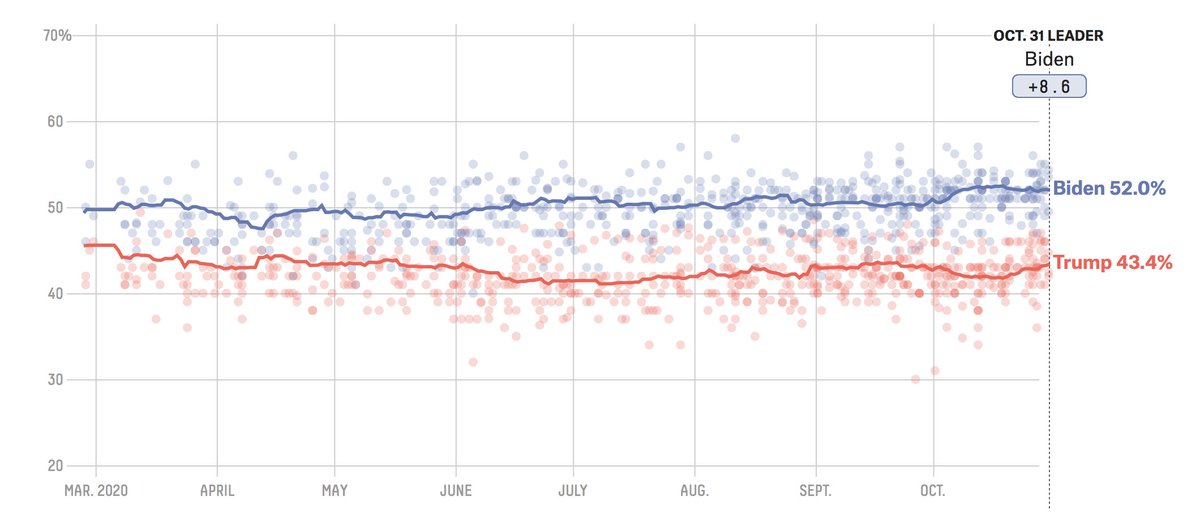Four reasons Biden has a better shot than Clinton did in 2016 -- and 2 reasons there's still uncertainty.
A summary :
:
1. Biden's lead is bigger and more stable than Clinton's was.
Clinton's lead was smaller throughout, and more unstable. Biden's has never been < 6.6 points.
A summary
 :
:1. Biden's lead is bigger and more stable than Clinton's was.
Clinton's lead was smaller throughout, and more unstable. Biden's has never been < 6.6 points.
2. There are fewer undecideds than 2016.
A week before the 2016 election, around 14% of respondents said they were undecided or intended to vote third party -- and the vast majority of late deciders voted for Trump: http://53eig.ht/2fIYJK2
This year, there are much fewer.
A week before the 2016 election, around 14% of respondents said they were undecided or intended to vote third party -- and the vast majority of late deciders voted for Trump: http://53eig.ht/2fIYJK2
This year, there are much fewer.
3. State polls have improved.
In 2016, it was state polls that had polling errors, in part because they hadn't needed to weight by education before ( https://www.ft.com/content/b3297609-e63b-4161-8287-7ab1179d0c40). But polls have improved ( https://53eig.ht/34wDia0 ), and there are more state polls now.
In 2016, it was state polls that had polling errors, in part because they hadn't needed to weight by education before ( https://www.ft.com/content/b3297609-e63b-4161-8287-7ab1179d0c40). But polls have improved ( https://53eig.ht/34wDia0 ), and there are more state polls now.
4. Many have already voted.
Almost two thirds of the total number of 2016 voters have already voted. This reduces the probability that last minute surprises would drastically swing the race. https://www.washingtonpost.com/graphics/2020/elections/early-voting-numbers-so-far/
Almost two thirds of the total number of 2016 voters have already voted. This reduces the probability that last minute surprises would drastically swing the race. https://www.washingtonpost.com/graphics/2020/elections/early-voting-numbers-so-far/
Two reasons there's still uncertainty:
1. The coronavirus pandemic makes everything more complicated.
Voting behavior has changed, so it's hard to infer trends. And a rise in cases in the next few days might make people stay home who intend to vote on Election Day.
1. The coronavirus pandemic makes everything more complicated.
Voting behavior has changed, so it's hard to infer trends. And a rise in cases in the next few days might make people stay home who intend to vote on Election Day.
2. The rules are still in dispute.
e.g. in PA, MN, TX. This makes it harder to estimate turnout in advance, and the uncertainty and complexity can also depress turnout. https://fivethirtyeight.com/live-blog/trump-biden-votes/
e.g. in PA, MN, TX. This makes it harder to estimate turnout in advance, and the uncertainty and complexity can also depress turnout. https://fivethirtyeight.com/live-blog/trump-biden-votes/
In conclusion: a 10% chance is a lot smaller than the 29% chance Trump had in 2016. But events with a 10% chance happen, you know, one in ten times. It's less likely, but not impossible. https://projects.fivethirtyeight.com/2020-election-forecast/
Basically, this: https://twitter.com/NateSilver538/status/1322668872936394752

 Read on Twitter
Read on Twitter



